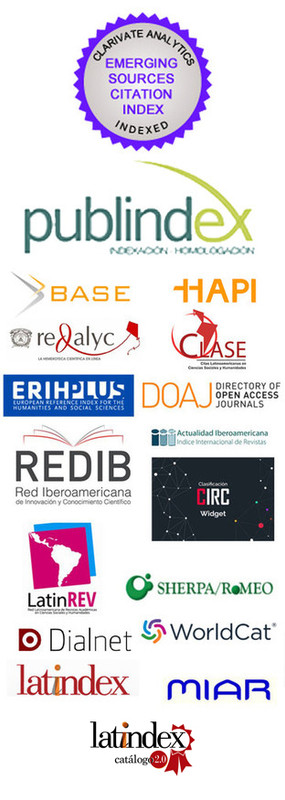
DOI:
https://doi.org/10.14483/21450706.22275Publicado:
2025-07-04Número:
Vol. 20 Núm. 38 (2025): Vol. 20 Núm. 38 (2025): Julio-diciembre 2025Sección:
Sección CentralDefining an AI-Generated Artwork: A Transdisciplinary Concept for Cognitive Science, Computer Science, and Art Theory
Definición de una obra de arte generada por IA: un concepto transdisciplinario para la ciencia cognitiva, la informática y la teoría del arte
Definindo uma obra de arte gerada por IA: um conceito transdisciplinar para ciência cognitiva, ciência da computação e teoria da arte
Palabras clave:
obras de arte generadas por IA, inteligencia artificial, arte, creatividad, definición (es).Palabras clave:
AI-generated artwork, artificial intelligence, art, creativity, definition (en).Palabras clave:
obras de arte geradas por IA, inteligência artificial, arte, criatividade, definição (pt).Descargas
Resumen (en)
The burgeoning capacity of artificial intelligence (AI) to generate artworks has ignited substantial interdisciplinary interest. However, the absence of a shared conceptual framework has hitherto impeded effective communication and collaboration among cognitive science, computer science, and art theory. This study addresses this lacuna through a comprehensive literature review by developing a transdisciplinary definition of an AI-generated artwork. It is proposed that an AI-generated artwork constitutes the confluence of three essential elements: (1) an autonomous AI-production of a new and surprising idea or artifact, (2) which passes an internal evaluation mechanism embedded in the very same AI, and (3) is considered a candidate of appreciation by a human audience. This definition provides a unified conceptual foundation to facilitate interdisciplinary research and deepen understanding of the nature of AI-generated art. Subsequent research should explore the applicability of this definition to diverse forms of AI-generated artworks and evaluate its implications for artistic practices.
Resumen (es)
La creciente capacidad de la inteligencia artificial (IA) para generar obras de arte ha despertado un gran interés interdisciplinario. Sin embargo, la ausencia de un marco conceptual compartido ha impedido hasta ahora la comunicación efectiva y la colaboración entre la ciencia cognitiva, la informática y la teoría del arte. Este estudio aborda esta laguna a través de una revisión exhaustiva de la literatura mediante el desarrollo de una definición transdisciplinaria de una obra de arte generada por IA. Se propone que una obra de arte generada por IA constituye la confluencia de tres elementos esenciales: (1) una producción autónoma de IA de una idea o artefacto nuevo y sorprendente, (2) que pasa por un mecanismo de evaluación interno integrado en la misma IA, y (3) es considerada candidata a ser apreciada por el público humano. Esta definición proporciona una base conceptual unificada para facilitar la investigación interdisciplinaria y profundizar la comprensión de la naturaleza del arte generado por IA. Las investigaciones posteriores deben explorar la aplicabilidad de esta definición a diversas formas de obras de arte generadas por IA y evaluar sus implicaciones para las prácticas artísticas.
Resumen (pt)
A crescente capacidade da inteligência artificial (IA) de gerar obras de arte tem despertado um grande interesse interdisciplinar. No entanto, a ausência de uma estrutura conceitual compartilhada até agora impediu a comunicação e a colaboração eficazes entre a ciência cognitiva, a ciência da computação e a teoria da arte. Este estudo aborda essa lacuna por meio de uma revisão abrangente da literatura, desenvolvendo uma definição transdisciplinar Defining an AI-Generated Artwork: A Transdisciplinary Concept for Cognitive Science. Propõese que uma obra de arte gerada por IA constitua a confluência de três elementos essenciais: (1) uma produção autônoma de IA de uma ideia ou artefato novo e surpreendente, (2) que passa por um mecanismo de avaliação interna integrado à própria IA e (3) é considerada candidata a ser apreciada pelo público humano. Essa definição fornece uma base conceitual unificada para facilitar a pesquisa interdisciplinar e aprofundar a compreensão da natureza da arte gerada por IA. Pesquisas futuras devem explorar a aplicabilidade dessa definição a várias formas de arte gerada por IA e avaliar suas implicações para as práticas artísticas.
Referencias
Arriagada, L. (2020). CG-Art: Demystifying the anthropocentric bias of artistic creativity. Connection Science, 32(4), 398–405.https://doi.org/10.1080/09540091.2020.1741514
Arriagada, L. (2023). CG-art: An aesthetic discussion of the relationship between artistic creativity and computation [University of Groningen]. https://doi.org/10.33612/diss.693764937
Boden, M. (2011). Creativity and art: Three roads to surprise. Oxford University Press.
Boden, M. (2017). Is deep dreaming the new collage? Connection Science, 29(4), 268–275.https://doi.org/10.1080/09540091.2017.1345855
Cetinic, E., & She, J. (2021). Understanding and Creating Art with AI: Review and Outlook. arXiv:2102.09109 [Cs]. http://arxiv.org/abs/2102.09109
Colton, S., & Wiggins, G. (2012). Computational Creativity: The Final Frontier? Proceedings of the European Conference on Artificial Intelligence, 242, 21–26. https://doi.org/10.3233/978-1-61499-098-7-21
Cope, D. (2003). Virtual Bach: Music By David Cope [Album]. Centaur.
Danto, A. (1964). The Artworld. The Journal of Philosophy, 61(19), 571. https://doi.org/10.2307/2022937
Davies, S. (1991). Definitions of art. Cornell University Press.
Dickie, G. (1969). Defining Art. American Philosophical Quarterly, 6(3), 253–256. JSTOR.
Dickie, G. (1997). Art: Function or Procedure: Nature or Culture? The Journal of Aesthetics and Art Criticism, 55(1), 19.https://doi.org/10.2307/431601
Elgammal, A. (2019). AI Is Blurring the Definition of Artist. American Scientist, 107(1), 18–21.
Elgammal, A., Liu, B., Elhoseiny, M., & Mazzone, M. (2017). CAN: Creative Adversarial Networks, Generating “Art” by Learning About Styles and Deviating from Style Norms. arXiv:1706.07068 [Cs]. http://arxiv.org/abs/1706.07068
Epstein, Z., Levine, S., Rand, D. G., & Rahwan, I. (2020). Who Gets Credit for AI-Generated Art? iScience, 23(9).https://doi.org/10.1016/j.isci.2020.101515
Gaut, B. (2010). The Philosophy of Creativity. Philosophy Compass, 5(12), 1034–1046. https://doi.org/10.1111/j.1747-9991.2010.00351.x
Giacomello, E., Lanzi, P. L., & Loiacono, D. (2018). DOOM Level Generation Using Generative Adversarial Networks. 2018 IEEE Games, Entertainment, Media Conference (GEM), 316–323. https://doi.org/10.1109/GEM.2018.8516539
Google Arts & Culture. (2019). Anna Ridler: Can datasets create art? - Barbican Centre. Google Arts & Culture. https://artsandculture.google.com/exhibit/anna-ridler-can-datasets-create-art-barbican-centre/iALiolnI1pkrLg
Hertzmann, A. (2018). Can Computers Create Art? Arts, 7(2), 18. https://doi.org/10.3390/arts7020018
Hertzmann, A. (2020). Computers do not make art, people do. Communications of the ACM, 63(5), 45–48.https://doi.org/10.1145/3347092
Hiller, L. (1989). Computer Music Retrospective [Album]. WERGO. https://www.discogs.com/release/6963452-Lejaren-Hiller-Computer-Music-Retrospective
Hsu, H. (2019, May 20). Machine Yearning. The New Yorker, 95(13), 83–84.
Jennings, K. E. (2010). Developing Creativity: Artificial Barriers in Artificial Intelligence. Minds and Machines, 20(4), 489–501.https://doi.org/10.1007/s11023-010-9206-y
Kaufman, J. C., & Beghetto, R. A. (2009). Beyond Big and Little: The Four C Model of Creativity. Review of General Psychology, 13(1), 1–12. https://doi.org/10.1037/a0013688
Kelly, S. D. (2019). A Philosopher Argues That an AI Can’t Be an Artist. MIT Technology Review. https://www.technologyreview.com/2019/02/21/239489/a-philosopher-argues-that-an-ai-can-never-be-an-artist/
Kőváry, Z. (2011). Psychobiography as a method. The revival of studying lives: New perspectives in personality and creativity research. Europe’s Journal of Psychology, 7(4), 739–777. https://doi.org/10.5964/ejop.v7i4.162
Lewis, G. E. (1993, October 10). VOYAGER [Album]. diskunion. https://open.spotify.com/album/3b7aYeFdeEtRH66nBOMEoz
Mäki-Reinikka, K. (2018, May 1). Cave Paintings for the AI: Art in the Age of Singularity. Politics of the Machines - Art and After.https://doi.org/10.14236/ewic/EVAC18.13
McCormack, J., Gifford, T., & Hutchings, P. (2019). Autonomy, Authenticity, Authorship and Intention in Computer Generated Art. In A. Ekárt, A. Liapis, & M. L. Castro Pena (Eds.), Computational Intelligence in Music, Sound, Art and Design (pp. 35–50). Springer International Publishing. https://doi.org/10.1007/978-3-030-16667-0_3
Mikalonytė, E. S., & Kneer, M. (2021). Can Artificial Intelligence Make Art? (SSRN Scholarly Paper ID 3827314). Social Science Research Network. https://papers.ssrn.com/abstract=3827314
Miller, A. (2020). Creativity in the Age of AI: Computers and artificial neural networks are redefining the relationship between art and science. American Scientist, 108(4), 244–250.
Miller, A. I. (2019). The artist in the machine: The world of AI powered creativity. The MIT Press.
Moffat, D. C., & Kelly, M. (2006). An investigation into people’s bias against computational creativity in music composition. Proceedings of the 3rd International Joint Workshop on Computational Creativity. ECAI06 Workshop.
Moruzzi, C. (2020a). Artificial Creativity and General Intelligence. Journal of Science and Technology of the Arts, 12(3), 84–99. https://doi.org/10.34632/jsta.2020.9481
Moruzzi, C. (2020b). Can a Computer Create a Musical Work? Creativity and Autonomy of AI Software for Music Composition. In S. Gouveia (Ed.), The age of artificial intelligence: An exploration (pp. 161–176). Vernon Press.
Moruzzi, C. (2020c). Learning through creativity: How creativity can help machine learning achieving deeper understanding. Rivista Italiana Di Filosofia Del Linguaggio, 14(2), 35–46. https://doi.org/10.4396/AISB201904
Moruzzi, C. (2021). Measuring creativity: An account of natural and artificial creativity. European Journal for Philosophy of Science, 11(1), 20. https://doi.org/10.1007/s13194-020-00313-w
Ragot, M., Martin, N., & Cojean, S. (2020). AI-generated vs. Human Artworks. A Perception Bias Towards Artificial Intelligence? Extended Abstracts of the 2020 CHI Conference on Human Factors in Computing Systems, 1–10. https://doi.org/10.1145/3334480.3382892
Ridler, A. (2018, September 17). Fall of the House of Usher. Datasets and Decay. V&A Blog. https://www.vam.ac.uk/blog/museum-life/guest-blog-post-fall-of-the-house-of-usher-datasets-and-decay
Ridler, A. (2021, June 5). Mosaic Virus, 2019. ANNA RIDLER. http://annaridler.com/mosaic-virus
Sawyer, R. K. (2011). Explaining creativity: The science of human innovation. Oxford university press.
Searle, J. R. (1999). Intencionalidad: Un ensayo en la filosofía de la mente. Altaya.
Stanowski, M. (2021). Theory and Practice of Contrast: Integrating Science, Art and Philosophy (1st ed.). CRC Press. https://www.taylorfrancis.com/books/9781000393644
Stein, M. (1953). Creativity and Culture. The Journal of Psychology, 36(2), 311–322. https://doi.org/10.1080/00223980.1953.9712897
Still, A., & d’Inverno, M. (2019). Can Machines Be Artists? A Deweyan Response in Theory and Practice. Arts, 8(1), 36.https://doi.org/10.3390/arts8010036
Turing, A. (1950). Computing Machinery and Intelligence. Mind, 59(236), 433–460. https://doi.org/10.1093/mind/LIX.236.433
Wellner, G. (2021). Digital Imagination, Fantasy, AI Art. Foundations of Science. https://doi.org/10.1007/s10699-020-09747-0
Worringer, W. (1997). Abstraction and empathy: A contribution to the psychology of style (1st Elephant pbk. ed). Ivan R. Dee.
Wu, Q., Zhu, B., Yong, B., Wei, Y., Jiang, X., Zhou, R., & Zhou, Q. (2021). ClothGAN: Generation of fashionable Dunhuang clothes using generative adversarial networks. Connection Science, 33(2), 341–358. https://doi.org/10.1080/09540091.2020.1822780
Cómo citar
APA
ACM
ACS
ABNT
Chicago
Harvard
IEEE
MLA
Turabian
Vancouver
Descargar cita
Licencia
Derechos de autor 2025 Leonardo Arriagada

Esta obra está bajo una licencia internacional Creative Commons Atribución-NoComercial-CompartirIgual 4.0.
Licencia actual vigente
Creative Commons BY NC SA - Atribución – No comercial – Compartir igual. Vigente a partir del Vol. 17 No. 32: (julio-diciembre) de 2022.
This work is licensed under a https://creativecommons.org/licenses/by-nc-sa/4.0/deed.es
Licencias anteriores
- Desde el Vol. 14 Núm. 25 (2019) hasta el Vol. 17 Núm. 31: enero-junio de 2022 se utilizó la licencia Creative Commons BY NC ND https://creativecommons.org/licenses/by-nc-nd/4.0/deed.es
- Desde el Vol 1 Num 1 (2007) hasta el Vol. 13 Núm. 23 (2018) la licencia fue Creative Commons fue Reconocimiento- Nocomercial-Sin obras derivadas 2.5 Colombia https://creativecommons.org/licenses/by/2.5/co/












